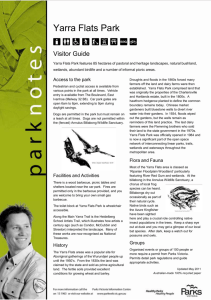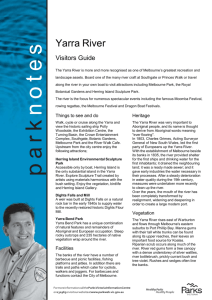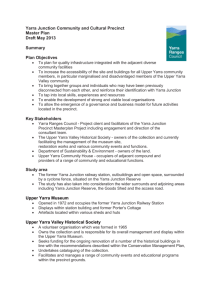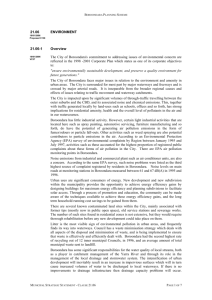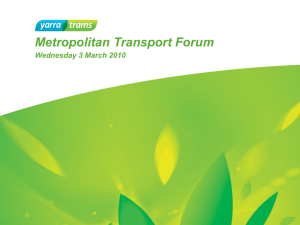The Yarra - UrbansystemsIGS
advertisement
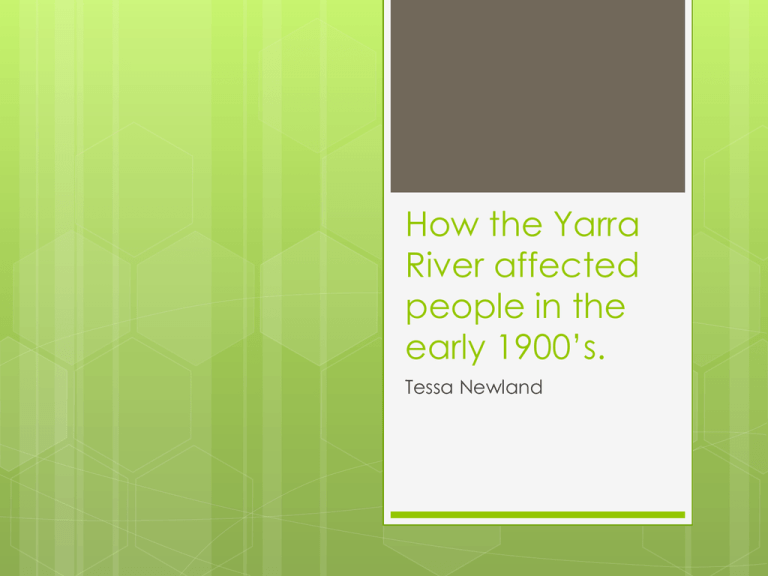
How the Yarra River affected people in the early 1900’s. Tessa Newland What is the geography of the Yarra River? From 1879 onwards, the Lower Yarra River’s course was significantly changed in order to eliminate floods. In 1886, the original loop in the river, west of today’s Docklands, was removed through the construction of a 1.5km canal called The Coode Canal (at Fisherman’s Bend). The Coode Canal was designed by a British Engineer, Sir John Coode. The Coode Canal was designed to improve access for ships to Melbourne’s main river docks. This construction took 20 years and shortened travel time for boats going up the river and also created the Victoria Dock. From the 1880’s onwards, the City Council improved the Yarra’s northern bank upstream of Princes Bridge to help the river flow more directly to Port Phillip Bay. Between 1924 and 1929, the council removed 24,000 items of natural debris from the river in order to improve flood control. In 1929, a new river channel was cut at Burnley, part of the Richmond precinct, creating Herring Island in the process. In the 1960’s the construction of the Eastern Freeway began, further altering the course of the River. Coode Canal, 1930 Herring Island, 1930 Victoria Dock, 1925 What is the importance of the Yarra River to Richmond in its early settlement? The Yarra River was a major source of food and a meeting place for indigenous Australians during the prehistoric times. Some of the food they were able to hunt in the Yarra included fish, short-finned eels, the Australian water rat and the Pobblebonk Frog. After the arrival of European settlers, land clearing forced the Wurundjeri people away from the river and into other territories. Before the European settlers settled in Melbourne there was an estimated 20,000 Aboriginals. Wurundjeri Tribe, 1835 How was the Yarra River used for transportation? Citizens used small paddle boats to make their way across the Yarra as an alternative to walking, driving (if they had cars) or by horse and cart. Another use was by businesses and trade markets, getting one product or material source to another place in a much simpler and quicker way. Businesses that wanted to trade used much larger boats called Steam Paddle Boats. They needed larger boats to simply fit a lot more on and a stronger build to assist in making it move faster. Larger Steam Paddle boat, 1885 Family paddle boats, 1900’s How did the floods of the Yarra River affect the people in Richmond? Just like today, floods caused an enormous amount of inconvenience. Homes were ruined, valuables were lost, people’s health were in danger and there was limited access to other places. Although the 1900’s and today’s impact of floods are very similar, the hype of it was much worse. This is because homes weren’t made out of as strong and good quality materials and there was a lack of health immunisations like the ones we have today. Yarra River Flood, 1934 How did the use of the Yarra River contribute to water pollution? In the early years of European settlement the Yarra River was used as a dumping ground for industrial waste. Some of the things that were dumping included paints, oils, metals and litter. Melbourne relied on the Yarra as a source of drinking water but because of the amount of waste within in it many residents were diagnosed with Typhoid and Diphtheria. (Typhoid is an infectious fever with an eruption of red spots on the chest and abdomen and severe intestinal irritation, caused by the bacterium and Diphtheria is a highly contagious disease caused by the bacterium Corvnebacterium diphtheria). This lead to a royal commission, resulting in a water treatment plant being built in Werribee in order to reduce water pollution. About 100,000 hectares of land around the source of the Yarra was blocked off from people to assist in providing higher quality drinking water for the people of Melbourne. This had a profound impact on the transport of people, the food they may have gained from the Yarra and many other inconveniences. Both a water treatment plant and land around the river being blocked off has been a major role in improving the Yarra River’s water quality for people in Melbourne today. Washed up waste, 1920 How was the Yarra River used in trade? They used the Victoria port as a place for ships to come in, deliver their goods and receive goods. The main imports and exports via the Yarra River included things like foods, goods (wool/materials, building materials) and coal. Due to the straightening and widening of the river the ability to trade became a lot more successful. The transportation of ships was therefore a lot faster and more efficient. Consequently to the Victoria Dock opening, by 1908 it was handling ninety percent of Victoria's imports. A beer trade, 1920 How did the Yarra River act as a border between the rich and poor people? Ever since people existed there has been a social order in which people are categorised due to their wealth, jobs and family history. Due to the Yarra’s floods wealthier people were situated at higher points of the land and poor people down the bottom. This border between them was due to many people’s needs to prove and show other people that they were important. The prices of homes in the 1900’s was much different to today and varied a great amount. Poor people paid around $400 to $800 at the most with the wealthier people paying $1,000 to $3,000. Wealthy people, 1920 Poor family, 1920 How did the pollution of the Yarra River affect the people? The Yarra River originally attracted people to it due to the amount of gold found within it and the business opportunities it held; however the pollution because of sewerage and industrial waste dumping into the river and the flooding that occurred caused the population to decrease dramatically. Water testing, 1920 What was the importance of the Yarra River to businesses and factories? The Yarra River was used by businesses, factories and industries. Having the Yarra River close to their businesses was a very convenient and free option to remove waste and save money and time. Factory in Melbourne, 1920 How was the Yarra River used for industrialisation? In the 19th century the mouth of the Yarra River was widened to make way for docks, harbours, bridges and other infrastructure. The increasing industrialisation of the river and the growth of the shipping industry saw the need for the creation of new shipping channels to cope with the growing use of the Yarra River by cargo ships in 1870’s. These cargo ships brought in things like coal. A new dock was excavated, eventually opening in 1892. (The dock was later renamed Victorian Dock.) In 1910, the main channel was widened and deepened to enable larger to ships to pass. In 1942, the old course of the Yarra River at Coode Island had been filled in and was completely gone by the1950’s. Between 1966 and 1972 Swanston’s dock was constructed and the use of Victoria Dock decreased and was completely disused by the mid- 1970’s. Submarine entering the industrialised area of the Yarra River, 1920 Yarra River’s worst floods In the century between the founding of Melbourne in 1835 and the devastating flood of 1934 it was the Yarra River that determined how the city developed. 1891: Nicknamed the ‘Great Flood’. The Yarra River rose 14 metres above its normal level in some areas. Flooded the riverside suburbs of Collingwood, Richmond and Prahran, causing extensive damage. Approximately 3,000 people were left homeless. 1934: 350mm of rain fell in 48 hours over the Yarra catchment, with 140mm falling over metropolitan areas. Six thousand people were left homeless, and eighteen people died. Flood, 1891 Flood, 1934 FUN FACTS Originally the Yarra River was called the ‘Birrarung’ by the Wurundjeri people. The current name ‘Yarra,’ was mistranslated by the Wurundjeri term “Yarra, Yarra.” Meaning‘ever flowing.’ The length of the Yarra River is 242 kilometres long. The Yarra River is brown because of the suspended silt carried downstream. The state of the river has dictated the amount of population size around the Yarra River. The population in the 1920’s was 1million compared to today’s population which is 4 million. The river is sometimes referred to as the river that’s runs upside down. 350 thousand cigarette butts enter the Yarra Catchment storm water runoff every day. There are jelly fish in the Yarra River. Turtles live in the Yarra River. I hope you enjoyed my PowerPoint.
